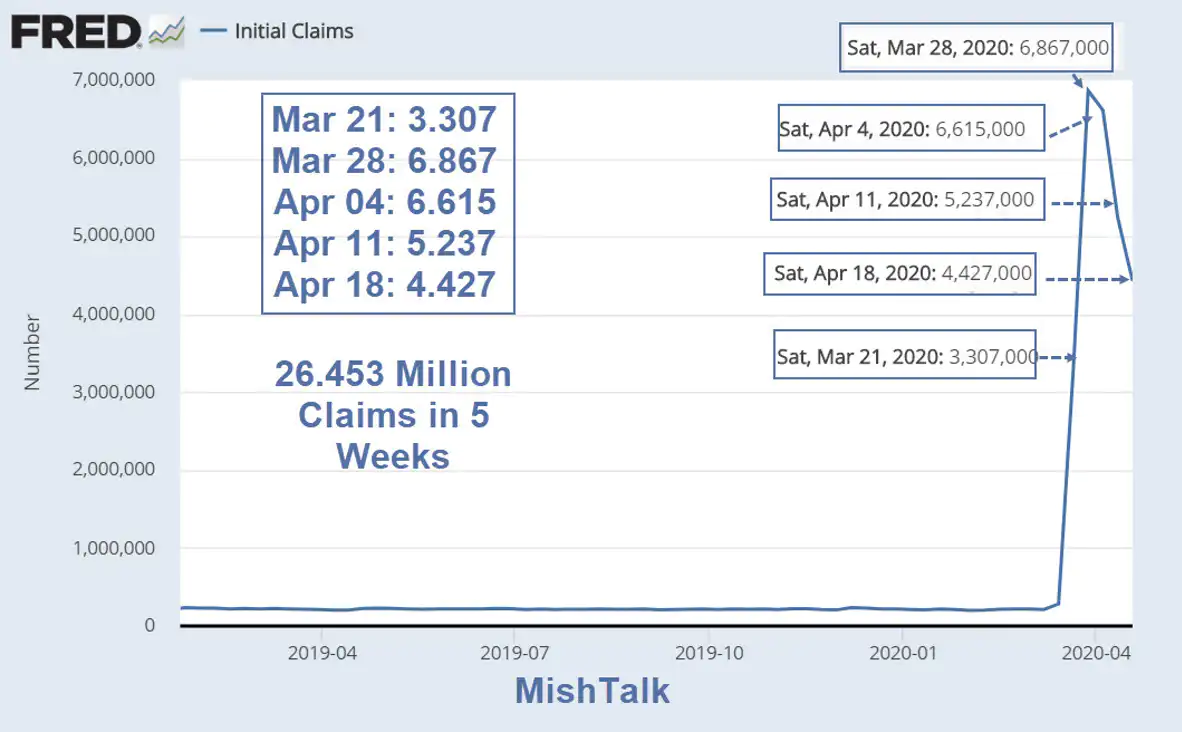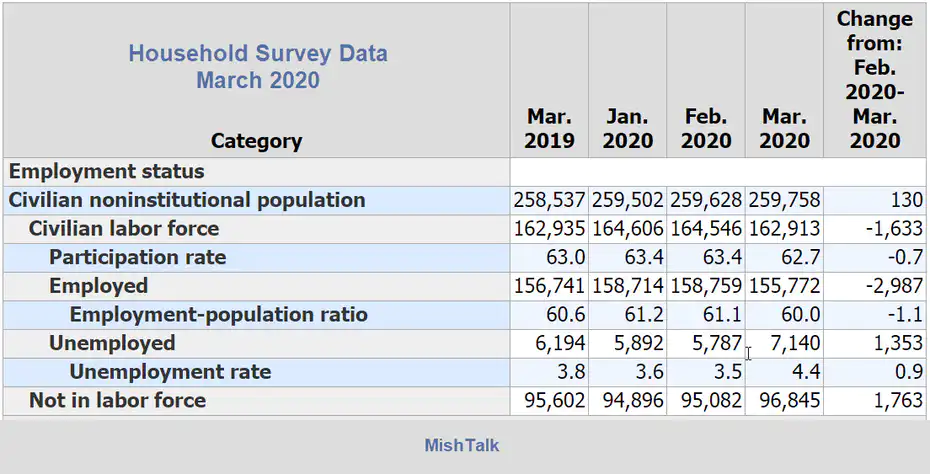
In the last 5 weeks, 26.453 million people filed unemployment claims. Let's estimate the unemployment rate.
With each passing week the grim stats add up. But it also makes it easier to estimate the unemployment rate for April.
Let's crunch the numbers starting with totals from the March Jobs Report and today's report Over 26 Million Unemployment Claims Filed in Just 5 Weeks.
Household Survey Numbers

Unemployment Rate Calculations
The unemployment rate does not come from claims. Rather, it comes from a phone survey in the week that contains the 12th of the month. That makes the current reference period April 12-18.
The March unemployment rate of 4.4% was wildly low (and will later be revised), because the reference week was before the mass layoff started. That will not be the case in April.
Estimate of Claims to Come
Over 26 million people filed a claim. But the important number is how many qualify who did not file.
Those people will turn up in the Household survey whether they filed or not. I estimate that count at 4 million.
Estimate of the Unemployment Rate
If we assume claims approximate Household Survey answers and further assume my estimate 4 million more qualify, we can estimate the unemployment rate as follows:
(New Claims + Existing Unemployed + Estimate of Claims to Come) / Labor Force
26.453 million + 7.140 million + 4.00 million / 162.913 = 23.1%
That is higher than my 18% Unemployment Estimate a Week Ago. Why?
- Last week I accidentally plugged in the "change" in unemployment of 1.353 million, not the existing unemployed at 7.120 million (undercounting by 5.767 million).
- We have another week of claims and my current total + new guess of claims to come is higher than last week. This is a net difference of about 3 million.
Prior to last week my estimates based on claims have been in the 21-24% range and here we are again.
Michigan Unemployment Rate
Michigan has been swamped with claims. Over a million people have filed for unemployment claims, out of a labor force of under 5 million.
A recent number crunch on Michigan yields an unemployment rate of 24%-29%, truly a disaster.
For details, please see Over 25% of Michigan Workforce Filed For Unemployment.
Caveats
- Just because people filed an unemployment claim does not mean they qualify according to BLS Household Survey guidelines.
- The reverse also holds true. People may qualify for unemployment without filing. Gig workers in particular fall into this category.
- Decline in Labor Force
- BLS uncertainties
- COVID-19 Relief Act
The BLS FAQ on the Impact of the Coronavirus Pandemic on the Employment Situation for March 2020 covers point #3.
Households are in the survey’s sample for a total of 8 months, meaning that interviewers attempt to interview someone in the household each of those 8 months. Generally, households entering the sample for their first month are interviewed through a personal visit, and households in their fifth month also often receive a personal visit. Interviews for other months are generally conducted by telephone.
For the safety of both interviewers and respondents, the Census Bureau suspended in-person interviews on March 20, 2020. Additionally, the two Census Bureau call centers that assist with telephone interviewing were closed. The response rate for the household survey was 73 percent in March 2020, about 10 percentage points lower than in preceding months.
Response rates for households normally more likely to be interviewed in person were particularly low [20% lower].
COVID-19 Relief Act
Please consider the Increased Unemployment Benefits Under the CARES Act (COVID-19 Relief Act).
Generally, if you take a leave or a reduction in hours as a result of the downturn, you will be eligible for Unemployment Insurance benefits. However, the scale and scope of these benefits will vary depending on the state where you are based.
The important points above concern a "reduction in hours" and the state-to-state variance.
Remember, in the Household Survey if you work as little as 1 hour you are not unemployed.
Potential Unemployment Overcounts in My Calculation
- Those furloughed but still getting paid are counted as employed, whether they filed a claim or not.
- People filing on the basis of reduced hours as per state law.
Potential Unemployment Undercounts in My Calculation
- People who worked no hours but did not file
- People not picked up in the BLS Household Survey who qualify.
I suspect we have more overcounts from people wanting free money than undercounts of people eligible but I do not know.
Let's crunch the number one more time assuming 6 million overcounts.
Factoring in 6 Million Net Overcounts
(New Claims + Existing Unemployed + Estimate of Claims to Come - Overcounts) / Labor Force
26.453 million + 7.140 million + 4.00 million - 6.00 million / 162.913 = 19.4%
Decline in Labor Force
I held the Labor Force constant. It won't be. Some people will retire.
The labor force fell by 1.633 million in March to 162.913 million. What if it fell by another 4 million.
26.453 million + 7.140 million + 4.00 million - 6.00 million / 158.913 = 19.9%
26.453 million + 7.140 million + 4.00 million / 158.913 = 23.6%
Synopsis Range
- If one assumes a 6 million overcount of claims vs what the household survey shows the estimated unemployment rate is 19.4% to 19.9%
- If one assumes no overcount the range is 23.1% to 23.6%
- If there is an undercount the rate may top 25%
My comfort range is 17-25% with an expectation of 20-24%
If the rate is way lower, then watch the increase in U-6 unemployment which counts all those working "part-time for economic reasons", even as little as 1 hour.
A U-6 rate well into the 30% range is likely in any case.
What's Next?
On March 23, I wrote Nothing is Working Now: What's Next for America?
I noted 20 "What's Next?" things.
COVID-19 Recession Will Be Deeper Than the Great Financial Crisis
On April 1, I commented, the COVID-19 Recession Will Be Deeper Than the Great Financial Crisis. Do not expect a V-shaped recovery.
Forever Changed
- More teleconferencing and fewer corporate lunches
- Less air travel, hotels, and car rentals at the personal and business level
- More work at home
- More do-it-yourself haircuts, nails, lawns, etc.
- Fewer car purchases
- Fewer home purchases
- Accelerated online shopping and more mall closures
The knock on impacts of all of those means more bankruptcies and less employment.
